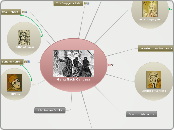door Dave O'Meara 13 jaren geleden
780
My Way to Canossa

door Dave O'Meara 13 jaren geleden
780

Meer zoals dit
The Walk to Canossa (sometimes called the Way to Canossa; German, Gang nach Canossa; Italian, l'umiliazione di Canossa) refers to both the trek itself of Henry IV of the Holy Roman Empire from Speyer to the fortress at Canossa in Emilia Romagna and to the events surrounding his journey, which took place in and around January 1077.
An investigation into the origins of The Song of Henry: A Modern English Translation of the Heinrichlied, Germany's Forgotten National Epic, English Translation by Roger McAllister, Victoria, B.C., 1992.
Elisabeth Nietzsche
Jakob Josephson
An investigation into the origins of The Meek Shall Inherit, cable television series, 2003-2004, story by Damien di Savoia Underwood.
Die sogenannte Antisemitenpetition war eine 1880/81 von deutschen Antisemiten der Berliner Bewegung veranlasste Petition an den Reichskanzler und preußischen Ministerpräsidenten Otto von Bismarck, die die Rücknahme wesentlicher Gleichstellungsgesetze für Juden verlangte.
Bernhard Förster (March 31, 1843, Delitzsch, Saxony—June 3, 1889, San Bernardino, Paraguay) was a nineteenth century German teacher. He was married to Elisabeth Förster-Nietzsche, the sister of the philosopher Friedrich Nietzsche.
Förster became a leading figure in the anti-Semitic faction on the far right of German politics and wrote on the Jewish question, characterizing Jews as constituting a "parasite on the German body". In order to support his beliefs he set up the Deutscher Volksverein (German People's League) in 1881 with Max Liebermann von Sonnenberg.
He left Germany in 1886 to emigrate to Paraguay and the following year he set up a colony known as "Nueva Germania". However, as this initiative was a failure, he eventually committed suicide by poisoning himself with a combination of morphine and strychnine in his room at the Hotel del Lago in San Bernardino, Paraguay on June 3, 1889.
Treitschke approached political history as a German nationalist and focused on those periods and characters in which great political problems were being worked out: above all, he was a patriotic historian, and he never wandered far from Prussia.
Johann Karl Friedrich Zöllner (1834 – 1882) was a German astrophysicist who studied optical illusions. He invented the Zöllner illusion where lines that are parallel appear diagonal. The lunar Zöllner crater is named in his honor. He also successfully proved Christian Doppler's theory on the effect of motion of the color of stars, and the resulting shift of absorption lines, via the invention of a very sensitive spectroscope which he named "Reversionspectroscope". He had shown also that the red-shift was in addition caused by variation in the stars' lights intensities with the help of his "Astrophotometer" (1865). Zollner became convinced in the reality of a fourth dimension after succumbing to the spiritualist trickery of the notorious medium Henry Slade.
"A poet is the creator of the nation around him, he gives them a world to see and has their souls in his hand to lead them to that world."
Herder gave Germans new pride in their origins, modifying that dominance of regard allotted to Greek art (Greek revival) extolled among others by Johann Joachim Winckelmann and Gotthold Ephraim Lessing. He remarked that he would have wished to be born in the Middle Ages and mused whether "the times of the Swabian emperors" did not "deserve to be set forth in their true light in accordance with the German mode of thought?".
Herder equated the German with the Gothic and favoured Dürer and everything Gothic. As with the sphere of art, equally he proclaimed a national message within the sphere of language.
Herder's focus upon language and cultural traditions as the ties that create a "nation"[1] extended to include folklore, dance, music and art, and inspired Jacob and Wilhelm Grimm in their collection of German folk tales.
Matilda of Tuscany (Italian: Matilde, Latin: Matilda, Mathilda) (1046 – 24 July 1115) was an Italian noblewoman, the principal Italian supporter of Pope Gregory VII during the Investiture Controversy. She is one of the few medieval women to be remembered for her military accomplishments. She is sometimes called la Gran Contessa ("the Great Countess") or Matilda of Canossa after the her ancestral castle of Canossa.
An investigation into the origins of Warrior, Daughter, Saint: the Story of St. Matilda of Canossa, by Sister Martin de Porres, OP, Dubuque, Iowa, 1973.
In April and May of 2009, an American blogger re-enacts the Walk to Canossa with the help of the original participants.